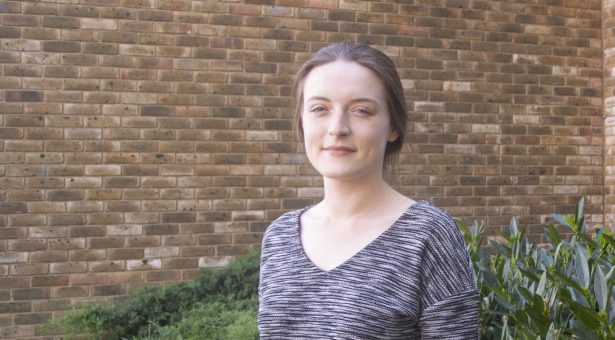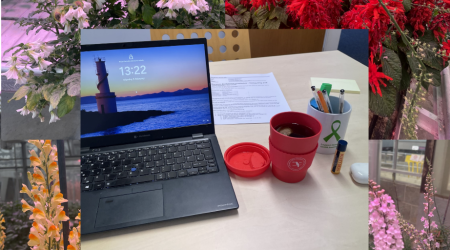An early passion for plant science; Introducing Caroline Stone

Caroline Stone is a second year PhD student in Professor Mark Banfield’s research group. We met with her to talk about her research project, and career journey that brought her to the John Innes Centre to study the structural biology of plant-pathogen interactions. Over to Caroline.
“In the Banfield group we work on the interaction between rice plants and the pathogen that causes rice blast disease, Magnaporthe oryzae.
Rice is one of the top four crops worldwide, and some Magnaporthe strains can infect wheat and other cereal crops, so Magnaporthe is of global interest. We use structural biology to ask questions about the molecular detail of how pathogens are detected by the plant immune system.
I work on a particular class of plant immune machinery called NLR proteins, which recognise damage or the presence of a pathogen and trigger the plant immune response.
In rice and other cereals, it is common that the NLRs work in a pair. One of the pair recognises the pathogen molecules, and the other is required to give the immune response.
Other labs in the field have produced structures of various singleton NLRs, which have brought a lot of insight into their function.
However, we don’t know the structure and mechanism of paired NLRs, and that’s what my project is looking into.
With structural biology projects you can either be lucky and things work the first time, or you can be unlucky, and things just never work. There is usually a lot of trouble shooting involved. That’s the nature of structural biology.
Now I’m in the second year of my PhD, and I’ve been making steady steps but I’m still working on isolating the pure protein to enable the structural analysis.
Luckily, I have a backup plan; there’s a lot of other exciting work that doesn’t require a purified protein but will still add useful information on the function of these NLRs.
The hope is once we understand exactly what these paired NLRs look like, they could be engineered at a protein level to recognise more disease variants. This could lead to rice plants with broader disease resistance, reducing yield loss and securing our future food supply.
An environmental benefit would be that plants with better disease resistance would require fewer applications of anti-fungal chemicals.
My mum is a biology teacher and has always had a great fascination with the natural world, which she passed on to both my sister and me. I liked all the science subjects at school, making it clear that a STEM related career was the likely path that I’d follow.
This led to a Natural Sciences undergraduate degree at the University of Cambridge. The nice thing about the degree was the ability to choose modules as you progress through the years. For me this ended up in mainly plant science modules, which I loved, but the lab work is what I enjoyed most.
I’d done a few summer projects, but committing to a PhD at this point didn’t sound ideal. I knew I wanted to try out full time research, so applying for Research Assistant jobs, I thought was a great way of getting this experience without the overall pressure of having to manage my own project.
After applying for various Research Assistant positions all over the UK in molecular biology and biochemistry, I accepted a role in the Carter lab at the MRC Laboratory of Molecular Biology. Over my three years there I received a lot of training in protein purification and biochemistry.
The lab uses a technique called cryo-EM (cryogenic electron microscopy), and I gained a real interest in structural biology during my three years in that position.
After two years in that role, it came to a point of figuring out what to do after my contract ended the next year. I knew I wanted to stay in science but progressing through multiple Postdoctoral positions to end up as a Group Leader wasn’t the career path for me.
I had always looked up to staff scientists, and I liked the idea of working in a facility and helping researchers with their projects. Searching through job adverts, these types of roles often required PhDs or lots of related work experience that I didn’t have yet. At this point I realised, ok it’s time to do a PhD.
Wanting to return to plant biology, my ideal PhD would be in a lab that asked plant biology questions using structural biology approaches. After researching advertised positions and reaching out to some other groups, two lab groups in the UK fit the criteria.
I asked to visit both to get a feel of the work environment and gauge whether they would be a good fit, and that’s how I ended up choosing a PhD in the Banfield lab.
In terms of lab life, so far, the PhD is what I expected. That partially comes from visiting the lab beforehand to meet the lab members, but also working as an Research Assistant and being surrounded by PhD students gave me a preview of the high and lows of research.
A great part of doing the PhD is having more control over your project. That being said, I’m always happy to take guidance from Mark about what the next sensible step would be.
The best advice that I could give if you’re thinking of doing a PhD is to research as much as possible. It’s probably better to focus on a few areas, scope out your future labs and make some early email enquiries.
If there’s a lab you are interested in and the adverts haven’t come out yet, write to the Group Leader to ask if they’re thinking of putting a project forward in the coming year.
Find out what type of PhD it will be, there are lots of good Doctoral Training Programmes around the UK such as the one here in Norwich and it’s nice to be part of a cohort and receive extra training. If you don’t know what topic you want to research, you could consider a rotation PhD programme.
Maintaining the work-life balance in a PhD is important.
The nature of the programme means that as long as you’re getting the work and hours done, it matters less when they’re being done. It gives you a bit of freedom to balance your life. For me, I do my best to keep weekends and sleep protected, and to make time to cook for myself.
The John Innes Centre is such a vibrant research community; we are united by our themes of food security, plant and microbe growth, and plant health, but the methods people use are really varied.
When you go to talks and seminars it’s fascinating, because you hear things you’ve never heard or thought about before. Another nice thing about a big institute is that there are a lot of people. Now that covid restrictions are subsiding, and people are able to mix a bit more freely, I’m finding a nice community.”
Caroline is funded by the BBSRC Norwich Research Park Biosciences Doctoral Training Partnership (NRPDTP)
This blog was written by Alex Borg, while he was on a Professional Industry Placement (PIPs) in the John Innes Centre’s Communications and Engagement Team. Alex is a BBSRC funded Doctoral Training Programme (DTP) student, affiliated with the University of Nottingham.



